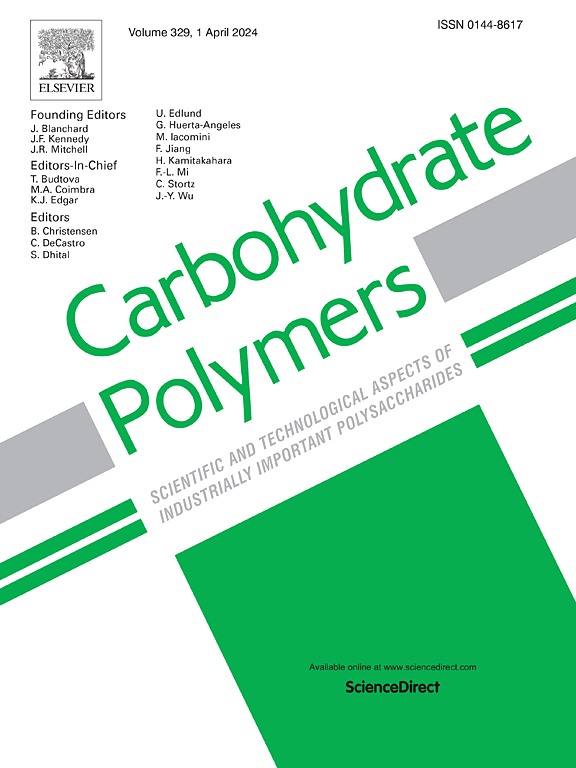抗菌阻燃tempo氧化纤维素纳米纤维/壳聚糖基海绵,高效捕获PM2.5
IF 10.7
1区 化学
Q1 CHEMISTRY, APPLIED
引用次数: 0
摘要
PM2.5可携带多种细菌,吸入后对健康构成严重威胁。因此,开发具有高效过滤和抗菌性能的多孔材料对于防止PM2.5对呼吸道健康的侵袭至关重要。在这项研究中,我们通过tempo氧化纤维素纳米原纤维(TCNF)、壳聚糖(CS)、氧化石墨烯(GO)和木质素混合颗粒的协同整合,设计了一种多功能海绵过滤器。通过酰胺交联在TCNF和CS之间构建了坚固的三维网络,赋予海绵优异的机械稳定性。氧化石墨烯通过静电吸附提高PM2.5截留效率。此外,我们引入了木质素纳米颗粒(LNP)作为生长氧化锌(ZnO)的载体,形成有机-无机杂化颗粒(LNP@ZnO)。这种方法将ZnO对海绵机械性能的负面影响降到最低,同时提高了抗菌性能。所得海绵过滤器对PM2.5的过滤效率高达99.14%,压降低(38 Pa),对大肠杆菌(92.63%)和金黄色葡萄球菌(89.05%)具有良好的抑菌性能,阻燃性能优异(LOI值为27.1%)。本研究通过最大限度地减少抗菌性能和机械强度之间的权衡,解决了现有系统的局限性,为设计先进的空气过滤材料提供了一种新的方法。本文章由计算机程序翻译,如有差异,请以英文原文为准。

Antibacterial and flame-retardant TEMPO-oxidized cellulose nanofibrils/chitosan-based sponge for efficient PM2.5 capture
PM2.5, which can carry many bacteria, poses a serious threat to health when inhaled. Therefore, developing porous materials with efficient filtration and antibacterial properties is essential for preventing the invasion of PM2.5 on respiratory health. In this study, we designed a multifunctional sponge filter through the synergistic integration of TEMPO-oxidized cellulose nanofibrils (TCNF), chitosan (CS), graphene oxide (GO), and lignin hybrid particles. A robust three-dimensional network was constructed via amide cross-linking between TCNF and CS, endowing the sponge with exceptional mechanical stability. GO enhances the PM2.5 interception efficiency through electrostatic adsorption. Additionally, we introduce lignin nanoparticles (LNP) as carriers for growing zinc oxide (ZnO), forming organic-inorganic hybrid particles (LNP@ZnO). This approach minimizes the negative impact of ZnO on the mechanical properties of the sponge while enhancing antibacterial performance. The resulting sponge filter demonstrates high PM2.5 filtration efficiency (99.14 %) with low pressure drop (38 Pa), excellent antibacterial properties against E. coli (92.63 %) and S. aureus (89.05 %), and outstanding flame-retardant properties (LOI value of 27.1 %). This study addresses the limitations of existing systems by minimizing the trade-off between antibacterial performance and mechanical strength, offering a novel approach for the design of advanced air filtration materials.
求助全文
通过发布文献求助,成功后即可免费获取论文全文。
去求助
来源期刊

Carbohydrate Polymers
化学-高分子科学
CiteScore
22.40
自引率
8.00%
发文量
1286
审稿时长
47 days
期刊介绍:
Carbohydrate Polymers stands as a prominent journal in the glycoscience field, dedicated to exploring and harnessing the potential of polysaccharides with applications spanning bioenergy, bioplastics, biomaterials, biorefining, chemistry, drug delivery, food, health, nanotechnology, packaging, paper, pharmaceuticals, medicine, oil recovery, textiles, tissue engineering, wood, and various aspects of glycoscience.
The journal emphasizes the central role of well-characterized carbohydrate polymers, highlighting their significance as the primary focus rather than a peripheral topic. Each paper must prominently feature at least one named carbohydrate polymer, evident in both citation and title, with a commitment to innovative research that advances scientific knowledge.
 求助内容:
求助内容: 应助结果提醒方式:
应助结果提醒方式:


